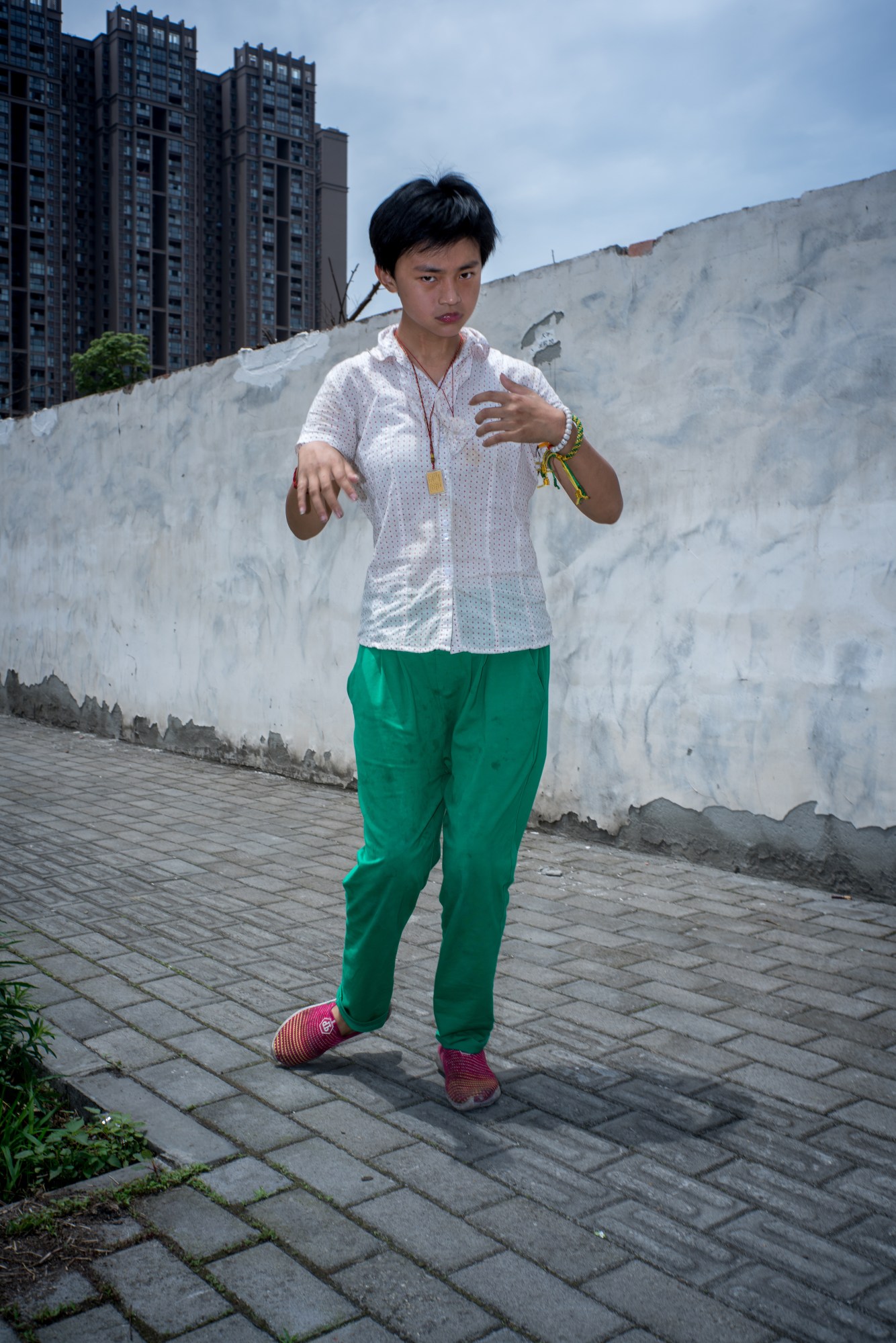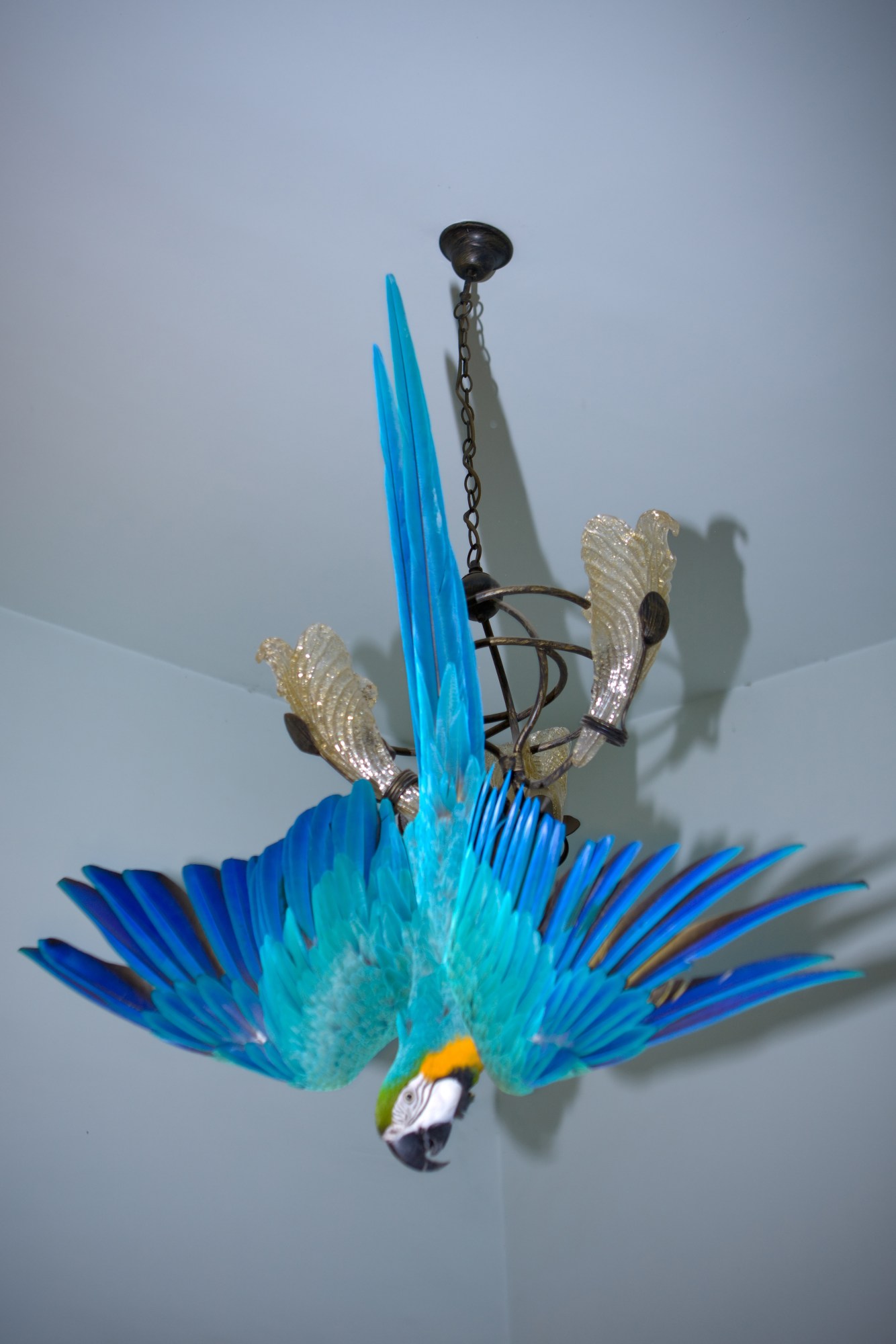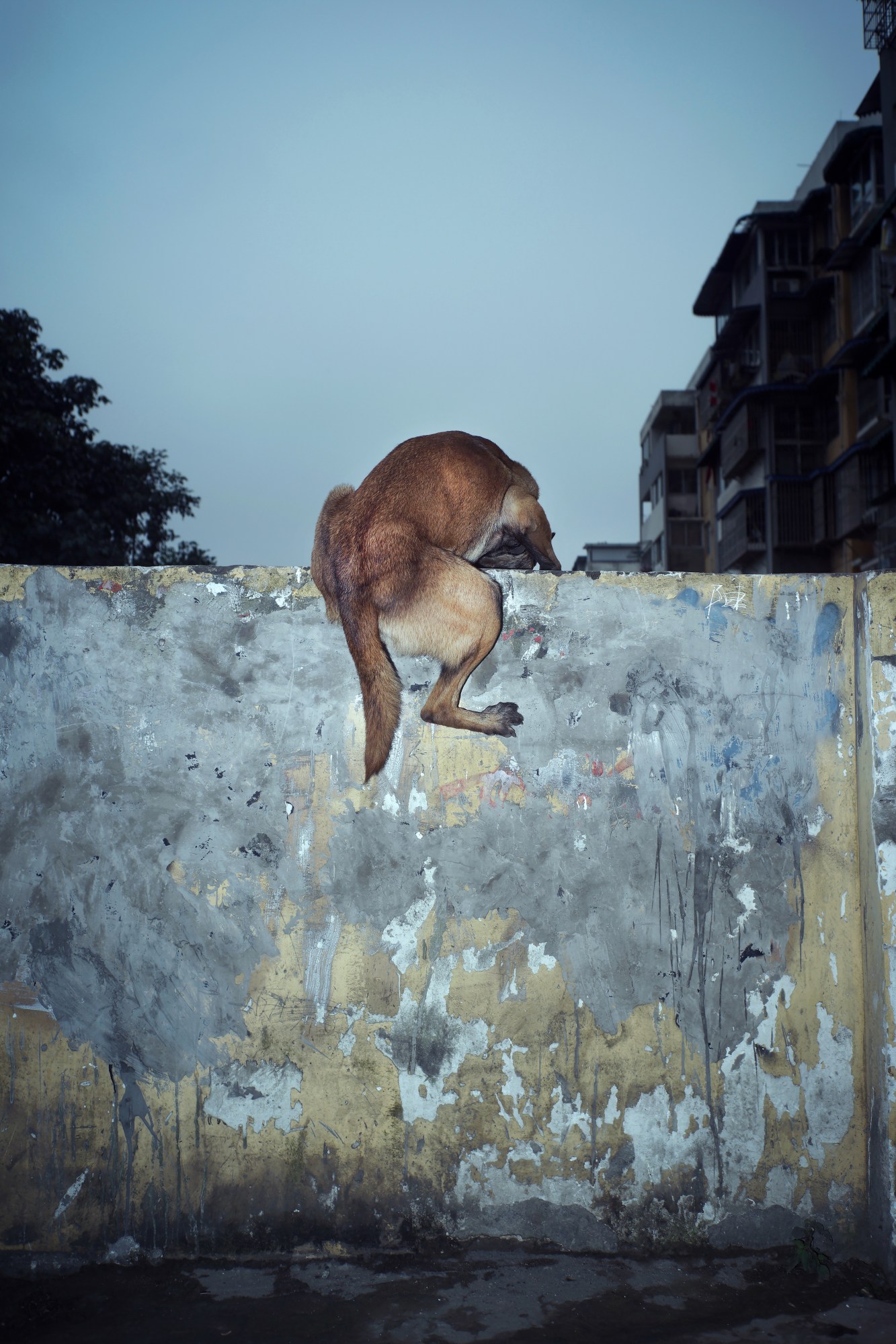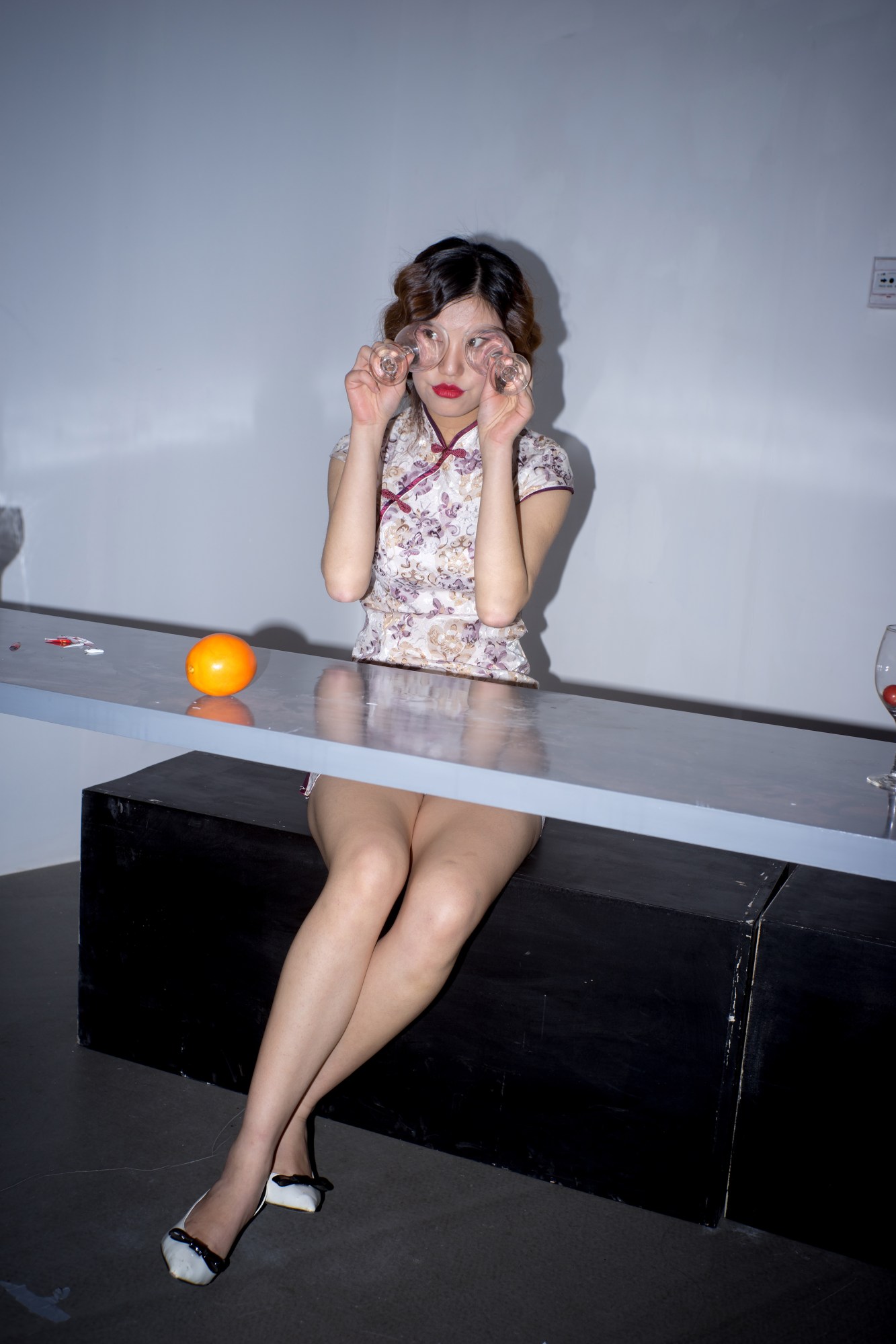Feng Li has been fueling his ongoing series “White Night” with idiosyncratic images since 2005. Born 1971 in Chengdu, Li initially studied Chinese medicine before practicing photography as a civil servant for the provincial Department of Communication and, in tandem, as an independent artist. He constantly toggles between personal work and official imagery, the former being completely antithetical to the propaganda of the latter.
Snapping pictures daily in the streets of Chengdu — capital of the Sichuan province and one of the most populous cities in Western China — chance encounters provide him with a constant source of material. His vision is characterized by surprising juxtapositions, tongue-in-cheek humor, bright textures and colors, all yielding a sense of the absurdity and even the uncanny within the urban landscape. The quotidian is examined under a bright flash, populated by inscrutable yet compelling characters: a figure in a silly bunny costume who, upon closer inspection, has an amputated left leg; a man casually lighting a cigarette despite an alarming amount of blood on his hand. The humorous and the sinister share a single frame: an uneasy, startling balance of violence and satire without any context.
Ll currently has a solo exhibition at the Rencontres d’Arles photography festival in the south of France, having won the Jimei x Arles Discovery Award in 2017 amongst a shortlist of ten emerging Chinese photographers selected by young curators. Li also has a carte blanche in Arles, taking photos of scenes from around the city, which will be updated regularly as a complementary in situ exhibition.
With the help of curators and ad-hoc translators Thomas Sauvin and Leo de Boisgisson, Feng Li discussed embracing the weird and mistrusting the notion of photographic truth.

How did you turn to photography?
I hated office life. I started taking photos for the sanitation department of the province as a way to escape it. Today, my job gives me a lot of freedom and access to events I wouldn’t otherwise have access to.
What are your photographic habits?
I shoot every day: that is a constant. I never go out with an intention to shoot something in particular, but I’m always on the lookout and I always happen upon bizarre things. There is an enormous amount of interesting, out-of-the-ordinary material — I’m never preparing anything, just being observant of what’s happening. I might like a shiny fabric or a collar or color , but don’t know the individuals. These small elements of texture give a bit of information about the subject, but it’s just linked to proximity. Details are transposable, and not linked to a place. I need to have people around — the countryside stresses me out.

How does your job as a civil servant dialogue with your personal portfolio?
Proportionally, my own photographic output is smaller. I can document the same venue I need to cover for work for myself by changing my angle, shifting my eye. The two practices complement each other; the official and the personal feed one another. It’s just the point of view that changes. I photograph what I need to for work but in parallel I create my own take. For example, I accompanied a director to a ribbon-cutting ceremony, which I photographed — and for myself, I looked up and took a photo of a man standing on the glass floor from an angle below.
What is your relationship to the people you photograph in the street?
It’s really photographing on the spot; I’m not there for a dialogue, it’s people who cross my path and I instinctively and rapidly take the photo. I’m not trying to understand them; it’s more about who’s in my field of vision. I have my preferred territory; I photograph in my immediate proximity. Most of the time, it’s people I don’t know — a woman opening champagne at my gallery opening, a woman in my neighborhood wearing green pants. There are also people I know — there’s a photo of my aunt. There’s one photo at a friend’s house party where someone is kind of putting on a show, kicking up his leg — he knows he’s being photographed. But the majority of the time it’s more random.

How did your eye change since you started in 2005?
The last two-three years I’ve gotten more precise in my observations. It’s easier and easier to find surreal moments in close proximity — it’s easy to appropriate in the everyday. It’s never about going further but rather looking closer. It’s always about proximity; there are amusing things to discover. Maybe it’s less that I’ve changed than the world around me is changing, and is crazier.
How so? In tracing that change, is there a sociological element to the exercise of photographing?
I don’t consider myself a sociologist in my photographic practice. Of course, because I document what’s around me, necessarily there are typologies that come out of the woodwork. Everyone seems increasingly stressed, nervous. Or maybe it’s me — maybe my interiority mixes in a little. The development in China in the last few years is crazy. Chengdu was a pretty laid-back place, and things have changed: there is a ton of construction and breaking of the landscape. There is a changing rhythm for sure, and maybe you can feel that when I shoot. But I’m not doing a panorama of those changes. I don’t have a particular stance.

Is there a photography community that you frequent? Are there any other local photographers whose works you like?
There is a very creative community; we boost each other. There are new festivals, a real appetite for photography, and I participate actively. I really like the photographer Han Lei, who’s from the complete center of China — it’s a dark, post-industrial China. His work is hard to describe, always a bit freaky. He depicts China, but it’s not a documentary approach. I like people who have their own universe.
The first photo is of a woman who looks distressed before a destroyed building. What was that one about?
This image has a lot of dramatic tension. It was in Jimei, at a festival where I was presenting my work. I left the exhibition and, as there is so much construction and destruction going on in the whole country, there were bulldozers. This woman, who looks upset, walks into the foreground but has nothing to do with the background — it’s not her house or anything — and she was maybe fighting with someone that you don’t see in the frame. The two are juxtaposed. I don’t know what happened, and I’m not looking to investigate. It looks like she’s trying to escape the bulldozers—but not at all. You can never believe photography. If I hadn’t taken these photos myself, I wouldn’t believe them.
Feng Li’s exhibition “White Night” on view at Maison Des Lices in Arles through August 26, 2018.

